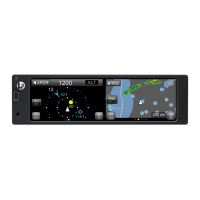Lynx NGT-9000s
Installation Manual
2.3.5.4.1 Directional Antenna Location
Location is an important factor for maximum antenna performance. Optimum location for a particular
aircraft type is usually available from the aircraft manufacturer. See Figure 2-15 for Antenna Outline
dimensions.
1. In selecting a location, consider the following:
• The mounting site should be on the top forward fuselage, as close to the centerline as possible,
and within -10° of the in-flight horizon (see Figure 2-14).
• The optimum mounting point for maximum coverage is as far forward as possible without
exceeding the -10° forward pitch.
• If necessary, consideration should be given to relocating other antennas to obtain the furthest
forward location for the directional antenna.
• The antenna should be mounted on the aircraft with at least 20 dB isolation (about 30 inches
(76.2 cm)) from other L-band frequency antennas and 24 inches (61.0 cm) from other antennas
or obstructions.
• The ground-plane should be as large as possible, a 30-inch (76.2 cm) ground-plane diameter is
recommended.
• Refer to the guidelines given for the GPS Antenna and L-Band (UAT/1090) Antennas for
additional spacing requirements.
• The directional antenna can be bottom mounted only if a suitable top mount location is not
available. Each bottom mount installation must be evaluated on a case-by-case basis. Before
starting a bottom mount installation, contact Field Service Engineering at 1-800-453-0288 or 1-
616-949-6600. Note - The bottom mount directional antenna eliminates the diversity option.
Figure 2-14: Directional Antenna Mounting Location
0040-17001-01 Installation Page 2-25
Revision A January 15, 2015

